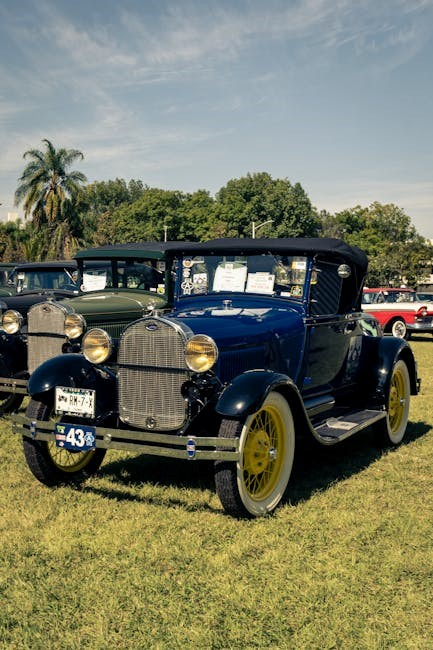Understanding your Gas Club car’s systems is key to effective troubleshooting. This guide helps identify common issues like fuel delivery‚ engine performance‚ and transmission problems. Learn to diagnose and resolve these efficiently‚ ensuring optimal vehicle performance and reliability.
The Basics of Gas Club Cars
Gas Club cars are designed with precision engineering to ensure optimal performance and reliability. These vehicles rely on advanced systems‚ including fuel delivery‚ engine ignition‚ and transmission mechanisms‚ to operate efficiently. Understanding the fundamental components‚ such as the gas tank‚ fuel pump‚ and engine management system‚ is crucial for troubleshooting common issues. Regular maintenance checks and knowing how to inspect key areas‚ such as the exhaust system and electrical components‚ are essential for preventing breakdowns. Proper care ensures the longevity and smooth operation of these vehicles‚ providing a seamless driving experience for owners.
Common Issues Faced by Gas Club Car Owners
Gas Club car owners often encounter challenges such as fuel delivery problems‚ engine performance issues‚ and transmission malfunctions. Fuel leaks‚ clogged fuel filters‚ and faulty injectors can disrupt smooth operation. Engine misfires‚ lack of power‚ and unusual noises may indicate deeper mechanical or electrical faults. Additionally‚ transmission issues like shifting difficulties or fluid leaks can compromise drivability. Addressing these problems promptly can prevent potential breakdowns and extend the vehicle’s lifespan. Routine maintenance and timely intervention are crucial to resolving these common issues effectively.
Purpose of the Troubleshooting Guide PDF
The Gas Club Car Troubleshooting Guide PDF serves as an essential resource for diagnosing and resolving vehicle issues. It provides clear‚ structured advice‚ helping owners understand common problems and solutions without prior technical knowledge. The guide ensures users can confidently navigate repairs‚ reducing reliance on professionals for minor fixes. Its actionable insights cover system-specific challenges‚ offering step-by-step solutions to keep the car running efficiently. This PDF empowers owners to perform regular maintenance and address concerns promptly‚ ensuring optimal performance and longevity for their Gas Club car.

Understanding Gas Club Car Symptoms
Identifying symptoms like stalling or poor acceleration is crucial for diagnosing issues. Detecting fuel leaks by smell or spillage‚ or noticing unusual warning lights‚ helps isolate problems. Ensure the battery is charged and check for signs of wear or damage to electrical components.
Common Symptoms of Gas Club Car Problems
Gas Club car owners often encounter symptoms like engine stalling‚ unusual noises‚ or poor fuel efficiency. One common issue is a fuel leak‚ which can lead to reduced power and dangerous fumes. Additionally‚ a weak battery may cause difficulty starting the vehicle. Pay attention to warning indicators on the dashboard‚ as they can signal underlying electrical or mechanical problems. If you notice these symptoms‚ it’s crucial to address them promptly to prevent further damage. Always refer to the troubleshooting guide PDF for step-by-step solutions tailored to your Gas Club car’s specific make and model.
When to Seek Professional Help
Knowing when to seek professional assistance is crucial for Gas Club car owners. If symptoms persist despite basic troubleshooting or if advanced diagnostic tools are required‚ it’s time to consult a certified mechanic. Issues like persistent engine stalling‚ severe fuel leaks‚ or complex electrical problems often demand specialized knowledge and equipment. Additionally‚ if you encounter advanced symptoms such as irregular fuel delivery or transmission troubles‚ professional intervention ensures a safe and effective resolution. Always prioritize safety and reliability when deciding Whether to tackle the problem yourself or seek expert help

Identifying Priority Symptoms
Identifying priority symptoms in your Gas Club car is crucial for effective troubleshooting. Symptoms like unusual engine noises‚ warning lights‚ or erratic behavior can signal critical issues. Prioritize symptoms that directly impact safety or performance‚ such as a faulty exhaust system or electrical malfunctions. Early detection prevents minor problems from escalating into costly repairs. Always refer to your troubleshooting guide PDF for detailed symptom analysis and solutions. By addressing these symptoms promptly‚ you ensure your Gas Club car runs efficiently and reliably‚ avoiding potential breakdowns or accidents. Proper symptom identification is the first step toward comprehensive repairs and longevity of your vehicle. Remember‚ ignoring warning signs can lead to severe damage‚ making proactive maintenance essential. Stay vigilant and act swiftly to maintain optimal performance.

Diagnostic Tools for Gas Club Cars
Effective troubleshooting requires reliable diagnostic tools. OBD-II scanners and manual inspections are essential for identifying issues. Advanced methods provide deeper insights‚ ensuring accurate and comprehensive problem-solving for Gas Club car maintenance and repair.
OBD-II Scanners and Their Role
OBD-II scanners are essential tools for diagnosing and troubleshooting issues in Gas Club cars. These devices connect to the car’s OBD-II port‚ retrieving diagnostic trouble codes and real-time data about engine performance‚ fuel systems‚ and emissions. By decoding these codes‚ you can identify the root cause of problems such as misfires‚ catalytic converter concerns‚ or sensor malfunctions. Modern OBD-II scanners often feature intuitive interfaces‚ making them accessible to both professionals and DIY enthusiasts. Regular use ensures early detection of potential issues‚ preventing costly repairs and maintaining optimal vehicle performance. Whether addressing a simple issue or unraveling complex fault codes‚ an OBD-II scanner is a trusted companion for Gas Club car owners.
Manual Inspection Techniques
Manual inspection is crucial for detecting and resolving gas club car issues. Start by examining the fuel tank‚ checking for leaks or blockages that could disrupt fuel delivery. Inspect the exhaust system for signs of rust‚ damage‚ or improper connections that may cause performance problems. Examine electrical components‚ ensuring all wiring and connectors are secure and free from corrosion. Look for visible signs of wear‚ such as frayed hoses or cracked belts‚ which can lead to mechanical failures. By systematically checking these areas‚ you can identify potential problems early and address them efficiently.
Advanced Diagnostic Methods
Advanced diagnostic methods for Gas Club cars involve specialized tools and techniques to identify complex issues. Real-time data analysis and computational modeling are used to evaluate performance metrics. Sophisticated software programs simulate potential problems‚ providing insights into system behavior. Infrared scanning and pressure testing help detect hidden issues‚ such as leaks or blockages. These methods ensure precise diagnostics‚ reducing the risk of misdiagnosis and expensive repairs. By leveraging cutting-edge technologies‚ advanced diagnostics enhance problem-solving efficiency and system reliability.
Manual Inspection of Gas Club Cars
Inspecting fuel systems‚ exhaust components‚ and electrical parts are crucial in manual Gas Club car inspections. Identifying issues early ensures smooth vehicle performance and prevents costly repairs. This guide helps you confidently examine and address common problems to maintain optimal functionality.
Checking Fuel System Components
Inspecting the fuel system is critical for maintaining optimal performance in your Gas Club car. Start by visually checking fuel lines and connections for leaks‚ corrosion‚ or damage. Ensure fuel filters are clean and free from debris‚ as clogs can restrict fuel flow. Test the fuel pump for proper functionality by checking pressure levels and listening for unusual noises. Examine fuel injectors for blockages and clean them if necessary to prevent uneven fuel delivery. Monitor fuel pressure using a pressure gauge or OBD-II scanner to ensure it matches manufacturer specifications. If you detect a strong gasoline smell or notice reduced fuel efficiency‚ investigate further for potential leaks or system failures. Always prioritize safety by using a gas sensor when working around fuel components.
Inspecting the Exhaust System
Inspecting the exhaust system is crucial for maintaining optimal performance and emissions compliance in your Gas Club car. Begin by checking for visible damage‚ corrosion‚ or leaks in the exhaust pipes‚ muffler‚ and catalytic converter. Look for discolored or cracked components‚ as these may indicate excessive heat or age. Test the oxygen sensor’s functionality‚ as faulty sensors can lead to reduced fuel efficiency and engine performance. Use a gas analyzer to measure emissions levels and ensure they meet regulatory standards. Clean or replace clogged exhaust systems to prevent backpressure‚ which can strain the engine. Regular inspection helps identify issues early‚ such as unusual noises or exhaust odors‚ ensuring the vehicle runs smoothly and safely.
Examining Electrical Components
Examining electrical components in your Gas Club car is crucial for diagnosing and resolving issues. Start by checking and testing fuses‚ wiring‚ and connectors to ensure they are clean‚ secure‚ and free of damage. Inspect the battery terminals for corrosion or loose connections‚ as these can cause power supply problems. Test electrical sensors‚ such as the oxygen sensor or temperature sensor‚ for accuracy and functionality. Additionally‚ verify the condition of the alternator and starter motor to ensure proper power distribution. Always use appropriate tools‚ such as a multimeter‚ to measure voltage and identify potential discrepancies. Addressing electrical issues promptly can prevent costly damages and improve overall vehicle performance. Always avoid common mistakes‚ such as improper wiring connections‚ to maintain reliable electrical system functionality.

Common Issues and Solutions
Fuel leaks‚ stalling‚ and battery issues are common in Gas Club cars. Start by inspecting fuel lines and connections for wear. Address stalling by checking air flow and ignition timing. For battery problems‚ ensure terminals are clean and connections secure. Regular maintenance can prevent these issues from escalating‚ keeping your vehicle running smoothly.
Fuel Delivery Problems
Fuel delivery issues are critical in Gas Club cars‚ as they directly impact engine performance. Common problems include clogged fuel filters‚ malfunctioning fuel pumps‚ or issues with the fuel injector system. These issues can cause symptoms such as difficulty starting the car‚ stalling‚ or rough idling. To resolve fuel delivery problems‚ it is essential to inspect and clean or replace components like filters and injectors. Additionally‚ checking for fuel leaks or fuel quality can help ensure smooth operation. Regular maintenance‚ including replacing fuel filters and inspecting fuel lines‚ can prevent long-term issues and improve the car’s efficiency and reliability.
Engine Performance Issues
Gas Club cars may experience engine performance issues such as decreased power‚ rough idling‚ or misfires. These problems often stem from fuel delivery or ignition system malfunctions. Check the spark plugs for wear or fouling and ensure all connections are secure. Dirty air filters or clogged fuel injectors can also hinder performance. If issues persist‚ consult the troubleshooting guide PDF for detailed diagnostics; Monitoring symptoms and prioritizing repairs can prevent further damage and extend the car’s lifespan. Remember‚ seeking professional advice through community forums or authorized repair centers is crucial for resolving complex engine issues effectively.
Transmission Troubles
Transmission issues in Gas Club cars often arise from worn belts‚ slipping gears‚ or fluid leaks. Symptoms like grinding noises‚ shaky shifts‚ or difficulty changing gears indicate potential problems. Over time‚ improper maintenance or excessive wear can damage internal components‚ leading to costly repairs. Always inspect fluid levels and check for leaks in the system. If you notice unusual behavior‚ address it promptly to prevent further damage. Regular inspections and following the maintenance schedule can help identify and resolve transmission troubles before they escalate. Remember‚ early intervention saves time and money in the long run.

Maintenance Tips for Gas Club Cars
Regular maintenance ensures optimal performance and longevity. Check oil levels‚ inspect belts‚ and rotate tires every 5‚000 miles. Replace air filters and spark plugs as recommended. Monitor fluid levels and heed warning lights to prevent costly repairs and extend your car’s life.
Regular Maintenance Schedule
Maintaining your Gas Club car regularly is essential for optimal performance and longevity. Follow this schedule: change the oil every 5‚000 miles‚ inspect air filters every 15‚000 miles‚ and check the fuel system annually. Clean or replace spark plugs every 30‚000 miles and inspect belts and hoses for wear. Inspect the undercarriage for rust or damage every 6 months. Replace cabin filters annually and ensure fluid levels are adequate. Monitor tire pressure and alignment during seasonal checks. Adhering to this schedule can prevent costly repairs and extend your vehicle’s lifespan.

Important Maintenance Checks
Maintenance is crucial for the longevity and performance of your Gas Club car. Regularly inspect the fuel system for leaks or blockages‚ ensuring proper fuel delivery. Check the engine’s oil levels and quality to prevent performance issues. Inspect belts‚ hoses‚ and spark plugs for wear and tear; replace them as needed. Monitor the air filter to maintain optimal airflow. Examine the battery connections and ensure they are secure to avoid electrical problems. Regularly inspect the exhaust system for damage or corrosion. Perform these checks to identify and address potential issues before they escalate‚ saving time and costs in the long run.
Frequent Mistakes to Avoid
Frequent mistakes when troubleshooting Gas Club cars include overlooking basic maintenance tasks‚ such as inspecting the fuel system or checking fluid levels. Ignoring warning lights or error codes can lead to more severe issues. Another common error is assuming problems are complex without performing a thorough manual inspection. Overreliance on advanced diagnostic tools without understanding the basics is also a mistake. Skipping regular maintenance or using incorrect oils and lubricants can damage components. Always prioritize safety and refer to the troubleshooting guide PDF for accurate solutions. Avoid rushing repairs without proper diagnosis‚ as this may worsen the problem. Stick to the guide and follow step-by-step procedures to avoid costly errors and ensure reliable performance.

Frequently Asked Questions
Thissection addresses common concerns about gas club cars‚ such as why the car is stalling‚ how to fix a fuel leak‚ or what to do if the battery dies. These FAQs provide practical solutions and insights to keep your vehicle running smoothly.
Why Is My Gas Club Car Stalling?
Your Gas Club car may stall due to issues like fuel delivery problems‚ electrical malfunctions‚ or mechanical failures. One common cause is a faulty fuel pump or clogged fuel filter‚ which disrupts the flow of gasoline to the engine. Additionally‚ a damaged ignition system‚ such as worn spark plugs or corroded wires‚ can prevent proper combustion. Another possibility is an air flow issue‚ caused by a malfunctioning mass airflow sensor or dirty air filter. If the car stalls while driving‚ it could indicate a problem with the engine’s timing or the car’s computer system. Regular maintenance‚ including checking fuel lines and inspecting spark plug connections‚ can help prevent stalling. If DIY fixes don’t solve the issue‚ consulting a professional mechanic is recommended for advanced diagnostics and repairs.
How to Fix a Fuel Leak
Fuel leaks in Gas Club cars can be dangerous and should be addressed immediately. Begin by locating the source of the leak. Common causes include loose fuel lines‚ cracked hoses‚ or faulty fuel injectors. Tighten any loose connections and inspect the fuel lines for damage. Replace worn or cracked hoses to prevent further leaks. If the issue persists‚ check the fuel tank for corrosion or damage. Apply a temporary fuel line repair kit if minor damage is found. For more severe issues‚ consult a mechanic or refer to the troubleshooting guide PDF for advanced solutions. Always ensure proper ventilation and avoid sparks when handling fuel. Regular inspections can help prevent future leaks and maintain vehicle safety.
What If the Battery Dies?
When a Gas Club car battery dies‚ the vehicle may fail to start‚ and dashboard lights may dim or turn off. To diagnose‚ check the battery terminals for corrosion and ensure they are securely connected. If the battery is old or frequently failing‚ it may need replacement. Jump-starting can temporarily resolve the issue‚ but repeated failures indicate a deeper problem. Charge the battery fully and test it with a multimeter. If it doesn’t hold charge‚ replace it immediately. To prevent future issues‚ use a battery maintainer during extended storage and inspect connections regularly. If the battery dies frequently despite proper care‚ consult a professional to check the charging system or starter motor.

Gas Club Car Resources
Find the official troubleshooting guide PDF for Gas Club cars on manufacturer websites and forums. Explore additional resources like repair manuals and user guides. Engage with online communities to share experiences and seek expert advice for Gas Club car owners.
Where to Find the Troubleshooting Guide PDF
To access the Gas Club Car Troubleshooting Guide PDF‚ start by visiting the official Gas Club website or manufacturer resource portal. Many car clubs and manufacturers provide comprehensive PDF guides for members. Additionally‚ forums like Ritetech.net and Reddit’s Gas Club communities often host shared troubleshooting documents. Always verify the source to ensure reliability. For more technical issues‚ check automotive publications or specialized forums focused on Gas Club car enthusiasts. These platforms frequently discuss diagnostic tools‚ repair methods‚ and PDF resources to help you resolve issues effectively.
Additional Reading Materials
To enhance your understanding of troubleshooting Gas Club cars‚ consider exploring additional resources. Dive into technical manuals covering fuel delivery systems and engine performance optimization. Online forums and automotive communities often discuss real-life scenarios and expert insights. For deeper knowledge‚ review case studies on gas storage and energy conversion‚ as these concepts apply to car diagnostics. Articles on fluid dynamics and safety protocols for handling fuels can also provide valuable context. Expand your research with these materials to strengthen your problem-solving skills and stay informed about the latest advancements in automotive troubleshooting.
Community Forums and Support
Gas Club car owners often turn to online forums and support communities for troubleshooting advice. These platforms provide access to expertise‚ troubleshooting tips‚ and reliable solutions. Many members share their experiences‚ offering insights into common issues and how to resolve them. Forums also serve as a space to ask questions‚ connect with other owners‚ and gain practical advice. By participating in these communities‚ users can find support and build their knowledge about Gas Club car maintenance and repair. The collective wisdom of the community is a valuable resource for addressing challenges and improving the performance of their vehicles.

Case Studies and Real-Life Examples
Explore real-life examples of Gas Club car issues and their solutions. Learn from case studies that demonstrate effective troubleshooting methods‚ including diagnosing complex problems and applying practical fixes. Gain insights into common scenarios to enhance your problem-solving skills and preparedness.
Sample Troubleshooting Scenarios
One common scenario involves a gas club car experiencing rough idling‚ which may indicate a dirty or clogged fuel filter needing replacement. Another situation is a fuel leak‚ which requires inspecting fuel lines and connections for damage or wear. A third scenario involves a malfunctioning exhaust system‚ such as rattling noises or reduced performance‚ pointing to potential issues with the muffler or exhaust manifold. Addressing these issues promptly prevents further damage and ensures reliable operation. By analyzing these scenarios‚ you can apply practical solutions to maintain your gas club car’s functionality and longevity.
Step-by-Step Solutions
When troubleshooting Gas Club car issues‚ follow these structured solutions: First‚ identify the root cause by reviewing common symptoms such as stalling‚ fuel leaks‚ or battery failure. If the problem is a fuel delivery issue‚ check for leaks or blockages in the fuel system. For engine performance problems‚ inspect spark plugs‚ fuel injectors‚ and oxygen sensors. In case of transmission issues‚ ensure proper fluid levels and inspect for worn components. Always maintain a regular maintenance schedule to prevent recurring problems. If unsure‚ consult the troubleshooting guide PDF or seek professional assistance. These steps ensure efficient and safe resolutions‚ extending the car’s lifespan and reliability.
Learning from Past Experiences
Learning from past experiences is crucial for improving your ability to troubleshoot Gas Club cars effectively. Reviewing previous issues and their solutions helps you recognize patterns and avoid recurring problems. By documenting each repair or maintenance task‚ you can develop a valuable reference guide for future challenges. Case studies and real-life examples provide insights into how others have resolved common and uncommon issues. Additionally‚ analyzing past mistakes ensures you approach new challenges with greater confidence and efficiency. Sharing experiences with fellow car owners or consulting forums can also enhance your understanding and problem-solving skills. Embracing past lessons allows you to refine your troubleshooting strategies and stay ahead of potential issues‚ making you more resourceful in diagnosing and resolving problems.





































































